Rubber plants are a wonderful option for new indoor gardeners looking to either start their adventure into the world of houseplants, as well as experience indoor gardeners who want to add to their garden. These plants are grown for their stunning deep green, leathery foliage and low-maintenance requirements.
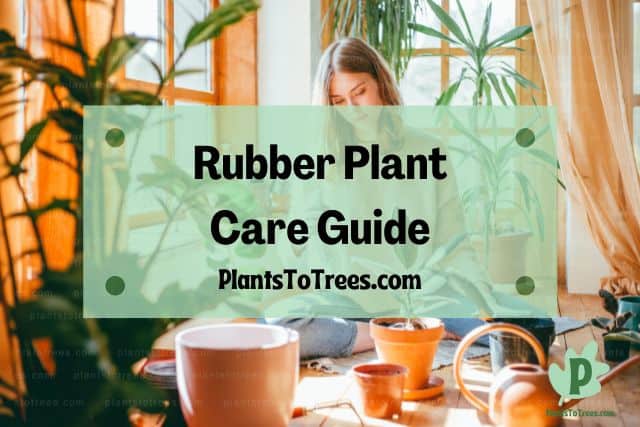
The rubber plant care guide will help you better familiarize yourself with the needs of this tropical houseplant. Because it is native to a tropical region, the rubber plant needs warm temps, moderate to high humidity, and soil rich in organic matter.
While it may seem like growing a tropical species indoors is difficult, it’s actually relatively easy. Rubber plants are not too fussy, and have a few problems that you have to worry about. The main concern with this plant is making sure it isn’t overwatered.
You should also strive to give the plant the right amount of light, water, and temperature. A little love goes a long way and taking the time to learn the rubber plant care guide and what this plant needs to thrive will ensure you are successfully growing this tropical plant.
One thing to consider is that this plant does contain an irritating sap that can cause problems if ingested or it touches the skin. So keep that in mind when deciding if the rubber plant is something you want to grow.
Other Names Of Rubber Plant
The rubber plant is the name that this plant is most commonly known by. But is it the only one? Let’s look at whether or not this popular houseplant goes by any other names.
The scientific name for the rubber plant is Ficus elastic, but it is also called the rubber bush, rubber tree, rubber fig, and Indian rubber push. This plant is native to South and Southeast Asia.
You may be wondering why knowing the other names that the rubber plant goes by would be important? Well, this information can help you connect with other people all over the world that may be growing the same plant but call it by a different name. Just do a simple Google search for rubber plant and then try another search using one of the other names. You may even see different results.
Frost Tolerance And USDA Hardiness Zones Of Rubber Plant
Before you start growing any plant, its best to find out whether or not it can tolerate frost, as well as what USDA hardiness zones the plant can grow in. If, however, you plan to merely grow this plant indoors, this information may not be as vital.
The rubber plant is not frost tolerant, but can be grown in USDA plant hardiness zones 9 to 11. With that said, you may have to provide the plant with a bit of protection during the winter if grown in zone 9. The best temperatures for this plant are 60 to 85 degrees Fahrenheit.
Just because you have a rubber plant growing indoors in a zone outside of the plant’s hardiness doesn’t mean you cannot move the rubber plant’s pot outdoors when the weather is warm. In fact, it is not uncommon for indoor gardeners to move most if not all of their indoor plants outside when the weather gets warm.
Keep in mind, however, that if you do decide to bring your indoor plants outside, make sure you relocate them back indoors when the temperature starts to drop. Most indoor houseplants shouldn’t be left outside if the temps are 60 degrees or below. You will also want to make sure they are protected while outside from strong winds, rain, hail, and direct sun.
How Many Hours Of Sunlight Does Rubber Plant Need?
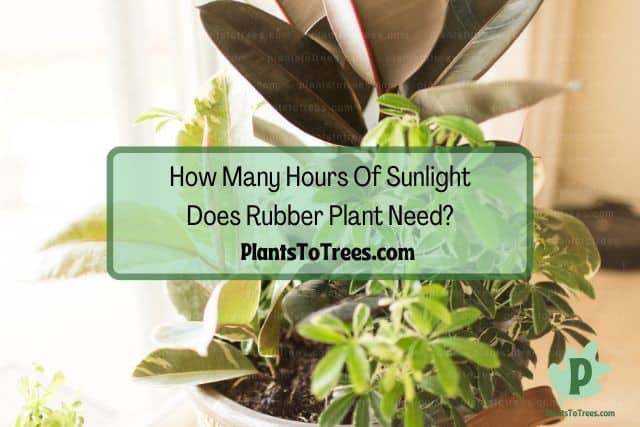
Some plants love the sun, requiring 12 or more hours of it every single day. While other plants prefer a more shaded area, with little to no sunlight. The rubber plant, however, falls a little in between.
Rubber plants need 6 to 8 hours of sunlight every day. The plant grows best when given medium to bright light. Just make sure it is indirect sunlight as direct light can result in burned leaves, leaf drop, and stunted growth.
If you’re unable to give the plant enough sunlight naturally, consider placing the rubber plant under grow lights. These lights can help supplement the plant’s lighting needs and, even though they are artificial, work well to mimic what the rubber plant would get from true sunlight. Just make sure the light isn’t directly on the plant, and that it is at least 12 inches away from the rubber plant.
Rubber Plant Needs Direct Or Indirect Sunlight?
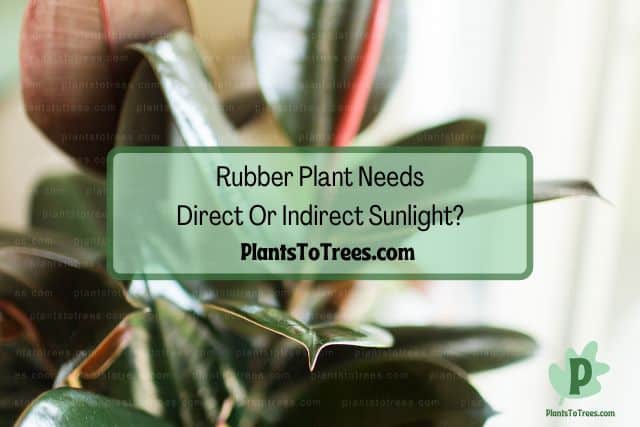
Did you know that not all plants can grow in direct sunlight? Direct sunlight can cause a slew of problems for various plants. But is the rubber plant one of those plants that can’t handle direct sun?
Like most other houseplants, the rubber plant needs indirect sunlight. Direct light will quickly take its toll on the plant, causing scorching or burning of the leaves, as well as stunting the plant’s growth. If the plant is getting direct sunlight, move it a new location immediately.
The ideal location for this plant is near a window that gets an abundance of sunlight. Just make sure to diffuse the light with a sheer curtain. Furthermore, make sure the plant isn’t too close to a window with hot glass, since this can cause the leaves to burn as well. If the window is getting too hot, simply move the rubber plant a few feet away.
Is Rubber Plant An Indoor Plant, Outdoor Plant Or Both?
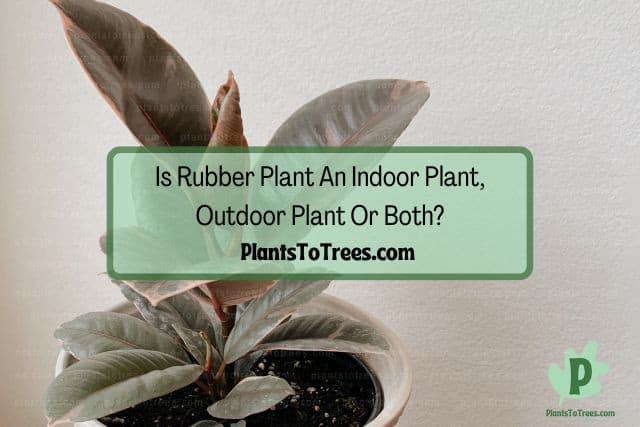
Whether or not the rubber plant is an indoor plant or an outdoor plant will have a direct effect on where you grow it. If it can grow outdoors, for example, that could potentially open up various options for your garden.
More often than not, the rubber plant is grown indoors as a houseplant. This is because most people do not live in the few USDA hardiness zones that this plant can grow outdoors in. If, however, you are in zones 9 to 11, you can plant it in the ground.
What Are The Indoor Lighting Requirements for a Rubber Plant?
Trying to achieve the right indoor lighting requirements for houseplants can be a chore. After all, you are generally limited to a few windows that may be blocked by various structures outside. You can, however, help improve your chance of providing the right light for the rubber plant by first knowing what lighting requirements this tropical houseplant has.
For indoor growing, the rubber plant will need 6 to 8 hours of indirect but bright sunlight. Next to a window that has a sheer curtain is the ideal indoor location.
Make sure to keep the rubber plant away from areas where the temperature will fluctuate rapidly, such as under or near a heating and cooling vent, drafty windows, or next to an exterior door. These extreme temperature fluctuations can cause the plant to go into shock.
What Are The Outdoor Lighting Requirements for a Rubber Plant?
Even though growing the rubber plant outdoors has a slew of challenges that growing it indoors does not, it still requires the same type of lighting.
As with indoor growing requirements, the rubber plant will need indirect sunlight even if it is planted outside. While the light needs to be indirect, it also needs to be bright. Avoid planting in a shaded area, and instead look for a location where there is dapple sunlight.
Remember, you should not try to grow the rubber plant outdoors in areas where the climate isn’t susceptible to this tropical plant. Doing so will quickly kill the plant and waste your time and money. If you want to grow plants outdoors, look for ones that can grow outside in your USDA hardiness zones.
What Soil Requirements Does a Rubber Plant Need?
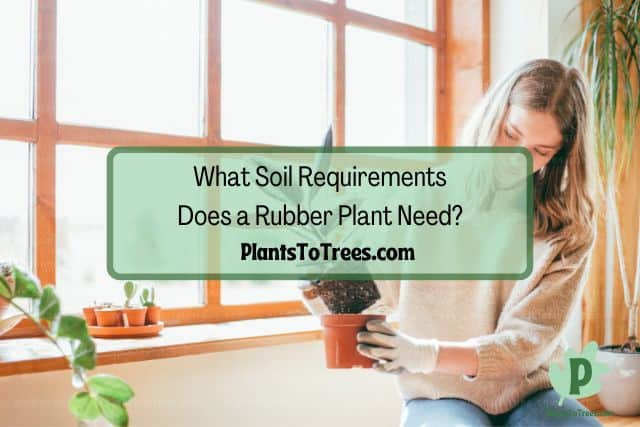
The soil that your plants are growing has a direct effect on the overall health of the plant. Selecting the wrong growing medium can quickly lead to serious problems that threaten the life of your rubber plant.
Rubber plants need soil that drains well and isn’t compact. These plants do not like their roots being soggy, so avoid allowing them to sit in water. Mixing 1 part peat, 1 part perlite, and 1 part pine bark is the ideal growing medium for the rubber plant.
If you’re not comfortable mixing your own growing medium, simply use an all-purpose indoor houseplant mixture. Indoor houseplant mixtures typically provide adequate drainage for most plants, including the rubber plant.
How Much Water Does a Rubber Plant Need?
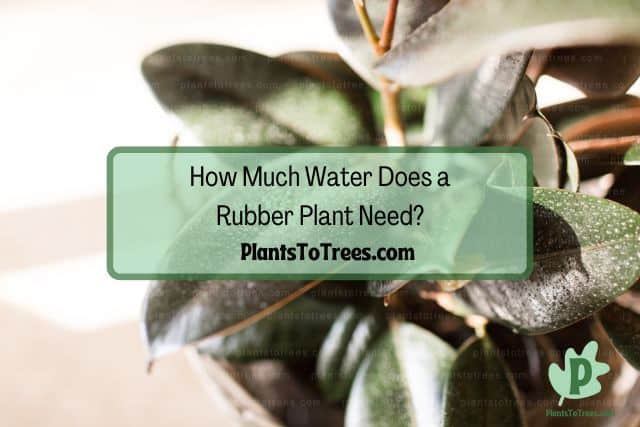
While hydrating your rubber plant is important, too much water can actually be a bad thing. To help prevent unnecessary damage to your rubber plant, make sure you don’t water it too much.
Since rubber plants don’t like sitting in soggy soil, it’s best to allow the growing medium to dry out a bit between watering. A good general rule of thumb is to water your plants every 1 to 2 weeks. You can check whether or not the plant needs watered by feeling the top one to two inches of soil.
Another thing to consider is whether or not you want to water the rubber plant with tap water, or distilled/filtered water. Some gardeners refuse to use tap water because of all the excessive minerals and potential chemicals that may be in it. While other gardeners feel that tap water is just fine. There are no hard facts or data that state one is always better than the other, so it is more of a personal preference. What is recommended, however, is that if you do use tap water, to set the water out for about 24 hours before using it to water your plants. This gives the water enough time to dechlorinate.
Is My Rubber Plant Overwatered, What Are The Symptoms?
Despite it being easy to avoid, overwatering is one of the most common downfalls of indoor houseplants. When a plant is overwatered, it cannot absorb the vital nutrients from the soil that it needs to survive. It also increases the chance of rot and other fungal diseases developing on your rubber plant.
An overwatered rubber plant will start to show signs in the leaves, such as yellowing, that something is wrong. However, once it hits this stage, fungal root rot may have already taken hold of the plant. Unfortunately, it is difficult to save a plant that has developed root rot.
A rubber plant that has been mildly overwatered can typically be saved by simply stopping all watering until the soil has dried out. For severe cases of overwatering, the plant will need to be removed from its pot and all the soil discarded. Any diseased or damaged roots will need to be removed and the plant will then have to be repotted in a clean and sanitized container.
Keep in mind, however, that even after repotting the plant, that doesn’t necessarily mean it will survive. More often than not, a rubber plant that has been severely overwatered cannot be saved and will need to be discarded in the trash.
Is My Rubber Plant Underwatered, What Are The Symptoms?
While you shouldn’t underwater the rubber plant, most can be brought back even after severe underwatering. Knowing what signs to look out for can help you stop the underwatering before it causes serious problems.
Underwatering a rubber plant will cause its leaves to start to curl at the edges, and feel dry and crispy. The lower leaves may also fall off the plant, and its growth will become stunted.
If you find yourself with an underwater rubber plant, grab a bucket and fill it with water. Set the rubber plant inside the water-filled bucket and let soak for a good 30 minutes. This will allow the water to penetrate the overly dried soil. After the allotted time has passed, carefully pick the rubber plant up and out of the bucket, allowing the excess water to fall back into the bucket. Set the rubber plant in its usual location and continue to care for it using the rubber plant care guide.
How Much Fertilizer Does a Rubber Plant Need?
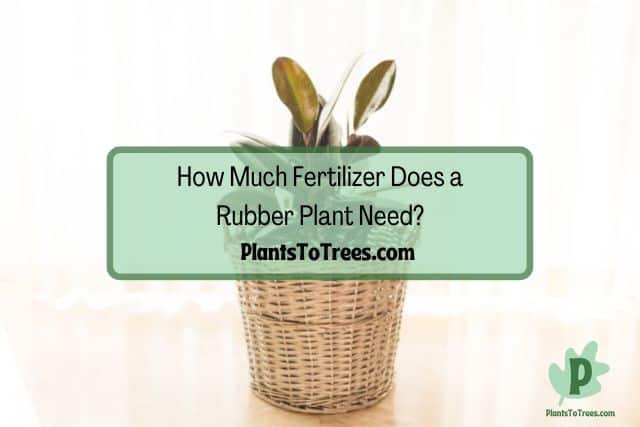
Rubber plants don’t require much feeding, but giving them a little fertilizer in the spring can help strengthen the plant and encourage new growth.
Apply the fertilizer to the rubber plant in spring once you see active growth forming. Use a balanced liquid fertilizer, such as 10-10-10. A slow-released formula in granular form works best for this tropical houseplant.
Since too much fertilizer can damage the rubber plant, follow the application guidelines that are listed on the back of the bottle.
Rubber Plant Diseases To Be Aware Of
As far as diseases go, the rubber plant doesn’t have many that you have to worry about. That doesn’t mean that this plant cannot develop a problem, it just isn’t as susceptible to diseases as other plants. Except for one potentially fatal disease.
Root rot is the most common disease affecting rubber plants. While this disease is no joke, it is easily preventable by merely making sure the plant is growing in well-drained soil and not overwatering the plant.
Once a rubber plant has developed root rot, it is extremely difficult to get rid of it. One of the reasons for this is because once symptoms present themselves above ground, it is usually too late.
If you want to try to save the rubber plant, you will need to remove the plant from its container and discard all the soil. This includes the soil that is around the roots of the plant as well. Once the soil has been removed, examine the roots and look for any that are brown, diseased, dead, or damaged, and then snip them off with a pair of sharp shears. Make sure to clean and sanitize cutting shears after you have used them. After you have removed the damaged roots, the rubber plant can be repotted in a clean container that is filled with fresh soil.
Are There Different Types Of Rubber Plants?
There are several different types of rubber plant, each with their own appearance and characteristics. Most, if not all, of these varieties, however, share similar growing requirements.
The scientific name for the rubber plant is Ficus elastica, and it is a member of the banyan group of figs. It is related to fiddle leaf figs, another common houseplant. There are various types of rubber plants, including ones with reddish-colored leaves, variegated leaves, and even dwarf varieties.
How To Propagate Rubber Plant
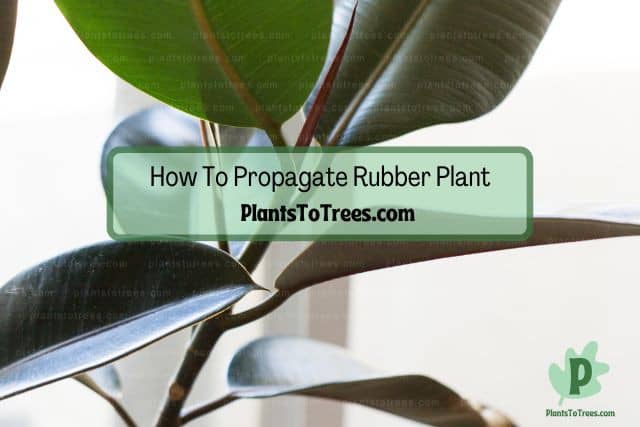
One of the benefits of growing houseplants is that you can typically propagate them relatively easily. The most common method of propagating rubber plants is the cutting method, which lets you take small cuttings from your plant and turn them into new plants.
Select a healthy stem from the rubber plant that you will use for propagating. Choose a stem that has about 3 leaves and then cut the stem just below a leaf node. Remove the bottom leaves from the stem and then plant in a soilless growing medium.
Before you plant the cutting, dip the bottom of it in rooting hormone to help encourage the cutting to root. Then plant it in a mixture of perlite and vermiculite. Set the cutting in a location where it is out of direct sunlight and heat, but will receive bright indirect light. Keep the soil moist but not soggy. In about 4 to 5 weeks, the cutting should start to develop roots.
You can also root the cutting in water. Simply place the cutting in a glass filled with water and let grow in an area where it will receive bright, indirect sunlight. Change the water once a week. Once the roots reach several inches long, transplant the cutting into soil and care for it as you normally would.
Is Rubber Plant Toxic To Humans?
A lot of common houseplants pose a risk to humans, but most of them don’t cause a serious health concern even if consumed. That doesn’t mean you shouldn’t research each plant’s toxicity before you bring it into your home. Far from it. Knowing how toxic a plant is, as well as what symptoms it can cause, is important to keep you and all those who share your home safe.
The rubber plant is listed as mildly toxic to humans. This plant contains an irritating milky sap that can cause irritation and burning to the mouth, throat, lips, and tongues if consumed. It can also result in gastrointestinal problems. Even if you simply touch the sap of this plant, it can still cause skin irritation.
If you have come in contact with the sap of the rubber plant, immediately wash it off with water and then wash the area with soap. Rinse the skin with water and then pat dry. In most cases, the sap will merely irritate the skin and last for a few hours to possibly a few days. If, however, the irritation gets worse or you have difficulty breathing, immediately seek medical attention as you may be allergic to the plant’s sap.
We at Plants To Trees first published this article on August 23, 2022. Copyright protected.
Is Rubber Plant Toxic To Dogs?
As a dog owner, you want to ensure your pooch is healthy and safe for as long as possible. One way to keep them protected is to check how toxic a plant is before you bring it through your front door.
The rubber plant is toxic to dogs and can cause stomach upset, dirahee, and drooling if consumed. It can also result in skin irritation if the sap of the rubber plant comes in contact with the dog’s skin.
Even though it is only mildly toxic, you should never allow your dog to play, eat, chew, or bother the rubber plant. Not only does it pose a risk to their health and can cause them to experience unpleasant symptoms, but it also gives them the idea that they can play with houseplants. While this may not seem like a problem now, it could potentially cause a slew of headaches for you in the future if you bring in a plant that you don’t want your dogs to bother.
Is Rubber Plant Toxic To Cats?
Cats are well known for their ability to get into things even if you think you put it out of their reach. And houseplants pose a unique challenge, since cats are typically drawn to new plants that are brought into their homes. That doesn’t mean you cannot have both houseplants and cats. It just means you need to ensure the plants are non toxic to cats before you grow them.
Rubber plants are toxic to cats, and can cause burning or irritation to the lips, mouth, tongue, and throat, as well as gastrointestinal problems. Cats who consume the rubber plant may also have excessive drooling and be lethargic.
The article owner is Plants To Trees dot Com and this article was first published on August 23, 2022.
If you do decide to grow a rubber plant in a house with cats, take care to keep the plant in a location where the cat cannot reach it. You can also train your cat to not bother the houseplants, and it typically requires giving them their own safe plants, such as catnip or cat grass.
Related Articles
Fiddle Leaf Fig Plant Care Guide
PlantsToTrees.com is the owner of this article and we first published this on August 23, 2022.
